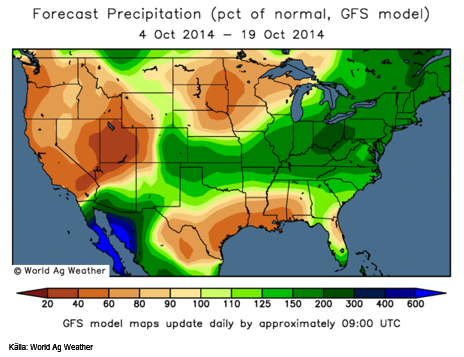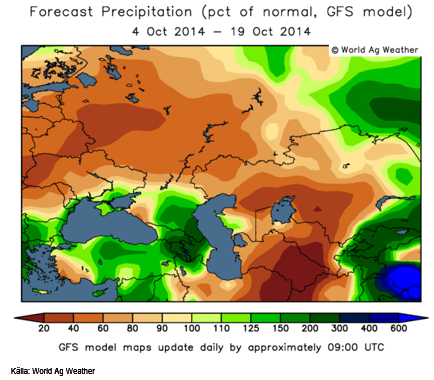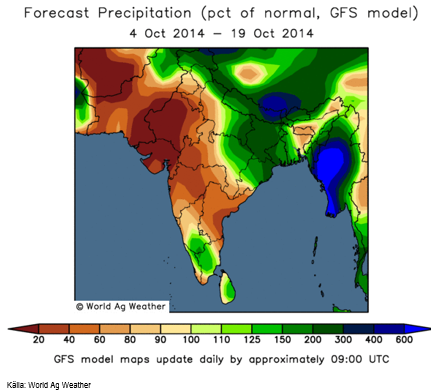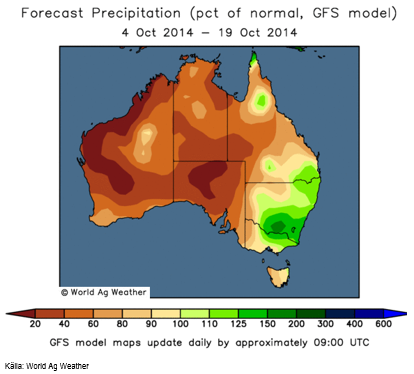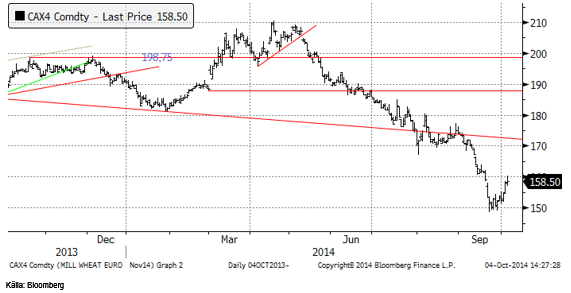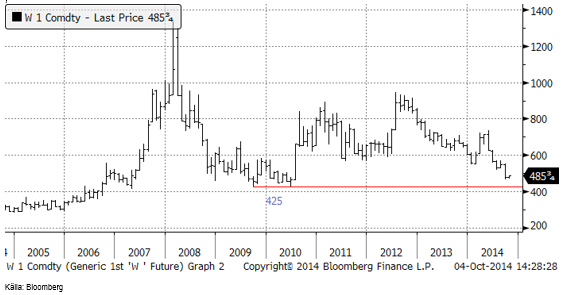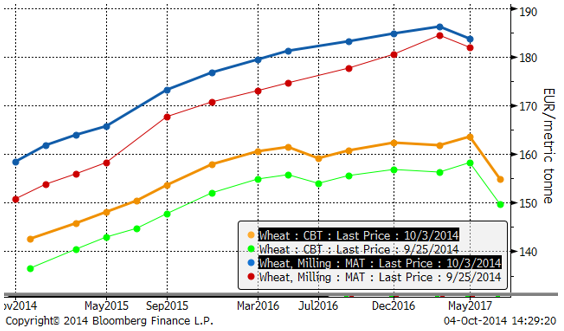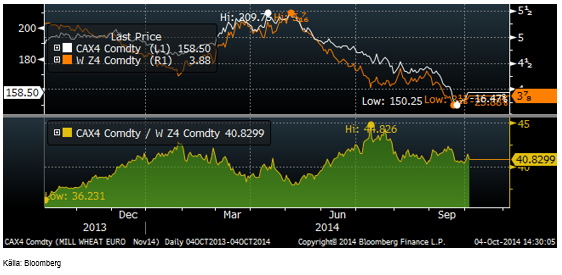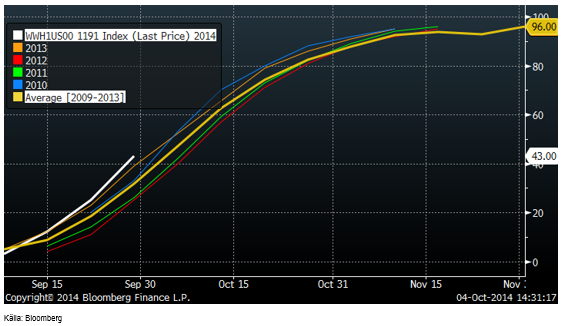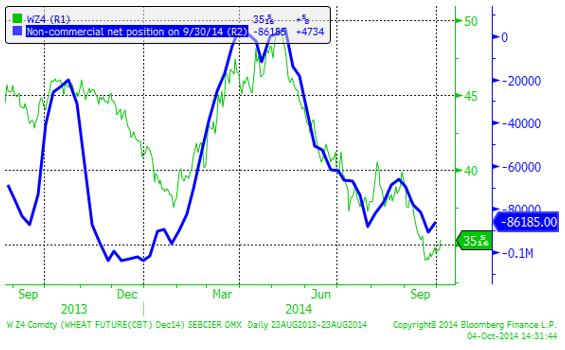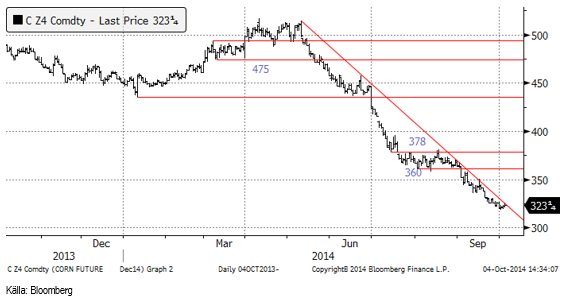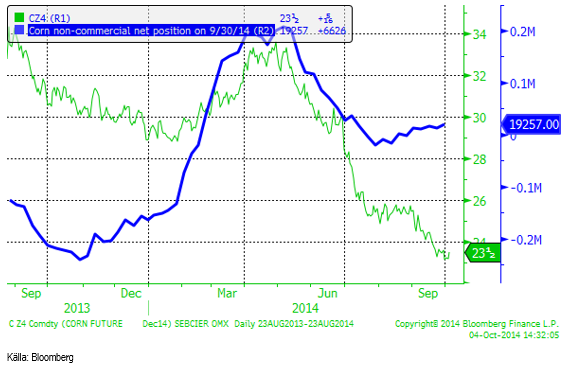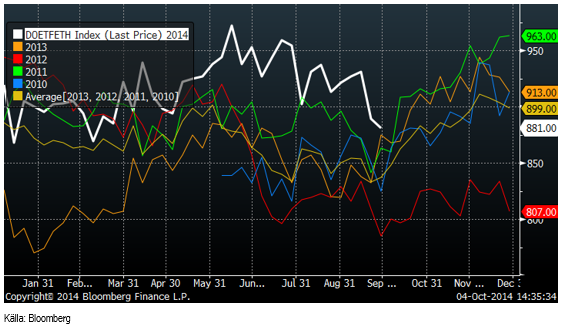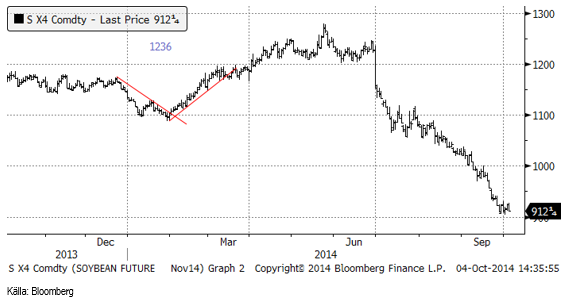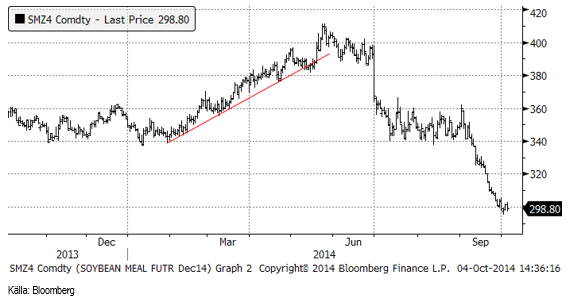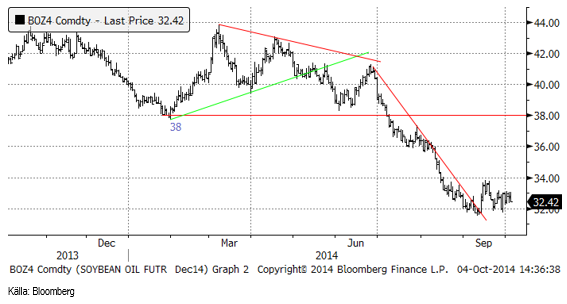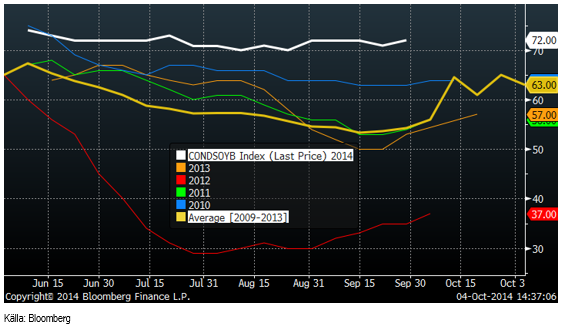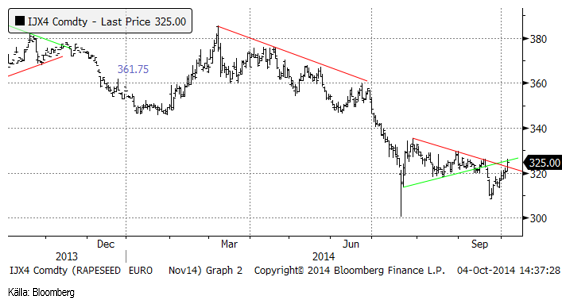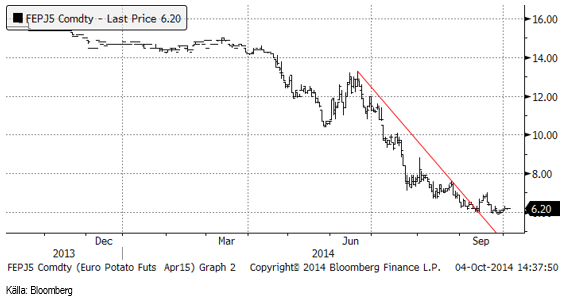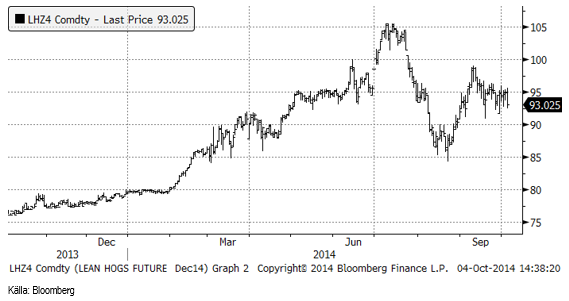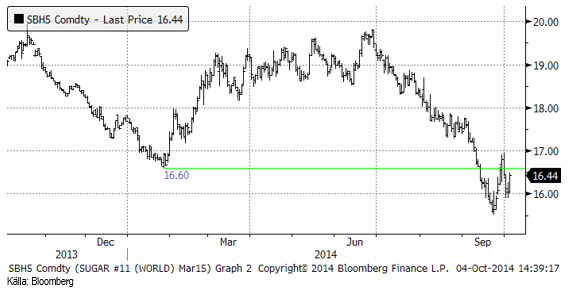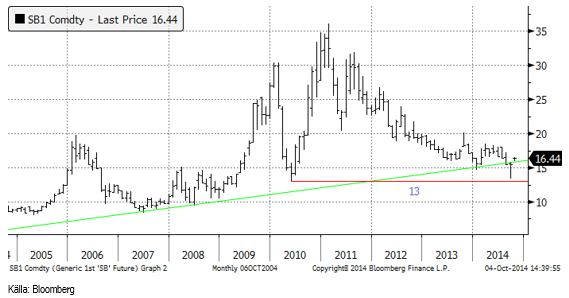Analys
SEB Jordbruksprodukter, 6 oktober 2014
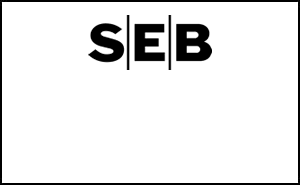

 Priserna på jordbruksprodukter har fallit mycket, mer än de flesta andra råvaror i år. Nu börjar prisfallen bli mindre och det finns tecken på trendbrott i flera av dem. Ett trendbrott innebär i sig inte att en ny trend uppåt etableras omedelbart, men det värsta är över och risk / reward är större på uppsidan än nedsidan.
Priserna på jordbruksprodukter har fallit mycket, mer än de flesta andra råvaror i år. Nu börjar prisfallen bli mindre och det finns tecken på trendbrott i flera av dem. Ett trendbrott innebär i sig inte att en ny trend uppåt etableras omedelbart, men det värsta är över och risk / reward är större på uppsidan än nedsidan.
Torkan i Brasilien, som är skrämmande intensiv är en trendförändrare. Den gör att skörden av sojabönor och majs omöjligen kan bli så stor som tidiga prognoser indikerat.
Odlingsväder
Som vi ser väntas västra Europa få upp till dubbla den normala nederbörden de kommande två veckorna. Det väntas regna över Skanderna, vilket fyller på vattenmagasinen inför vintern, vilket påverkar elpriset i Norden. Det är samtidigt väldigt torrt i östra Europa.
Prognoskartan för nederbörden i USA visar torrt väder i ’corn belt’ och blötare typiska veteodlingsområden som Kansas och Oklaholma.
Ryssland, Ukraina, Vitryssland, och överhuvud taget alla länder kring Svarta havet väntas på 40-60% av normal nederbörd de kommande två veckorna.
I Brasilien ser väderleksprognosen förskräckande torr ut. Stora och viktiga odlingsområden väntas få mindre än 20% av normal nederbörd de kommande två veckorna. Detta är en rejäl trendförändrare för soja, majs, socker och kanske kaffe.
Indiens monsun fortsätter att vara mindre intensiv än normalt.
Australien väntas få mindre nederbörd än förväntat, utom just i SW, där odlingen av vete huvudsakligen sker.
Vete
Vetepriset (novmeberterminen på Matif) har tagit sig upp från 150 euro nästan till 160. Där finns dock ett starkt motstånd och ur teknisk synvinkel skulle man kunna tänka sig en rekyl nedåt. Detta är dock ändå förmodligen en så låg nivå att det skulle kunna handla om de lägsta nivåerna för den här säsongen.
I nedanstående diagram ser vi hur Matifs ”spotkontrakt” utvecklat sig de senaste tio åren. Priset är på en nivå som tidigare varit bottennivåer. Därmed ska man inte utgå från att priset vänder upp från den här nivån genast. Tidigare har priset stannat på en låg nivå i flera månader, innan det vänt upp igen.
Chicagovetet (december) har en liten bit kvar på nedsidan innan marknaden rör vid ett starkt stöd.
Nedan ser vi terminskurvorna i fredags och en vecka tidigare för Matif respektive Chicago. Det är contango på båda marknader.
Matifs novemberkontrakt håller sig i samma relation som tidigare till Chicagos decemberkontrakt.
Sådden av höstvete har nått 43% färdigt. Det är den snabbaste takten de senaste åren och nästan 10% snabbare än genomsnittet för de senaste åren.
I den senaste GASC-tendern tog Frankrike hem allt, men till riktigt låga priser. Amerikanskt vete offererades inte alls.
StatsCanada visar på en skörd (preliminär) på 27.5 mt, 26.8 mt lägre än förra året. Det var i stort sett i linje med förväntningarna.
Non-commercials i CFTC:s rapport verkar ha passerat den mest korta positionen. I den senaste rapporten hade de köpt tillbaka en del av den korta positionen.
Det börjar utveckla sig till köpläge i vete. Det finns antagligen utrymme för en liten nedgång på kort sikt, men på längre sikt finns en klar uppsidespotential.
Majs
Decemberkontraktet CZ4, ligger som i ser i kursdiagrammet nedan, precis under motståndslinjen för den fallande pristrenden. Motståndet är ännu inte brutet, men det kan mycket väl ske den här veckan. Det markerar i så fall slutet på den fallande pristrenden. Det är inte detsamma som att en stigande pristrend tar vid, men ofta är det början på en uppgång.
Crop condition låg oförändrat på höga 74% good/excellent i måndags.
Non-commercials köpte ytterligare några kontrakt i veckan.
DOE rapporterade i veckan som gick att etanolproduktionen i USA sjönk igen, som vi ser i diagrammet nedan. Hösten är en säsongsmässigt svag period och produktionen kommer säkerligen att ta mer fart från mitten av oktober.
Vi vänder alltså till köprekommendation.
Sojabönor
Sojabönorna (SX4) har under september fallit från 1000 cent ner till 912. Det verkar som om det finns stöd för priset vid 900. Bryts det, finns nästa stöd vid 800 cent.
Sojamjölet föll, som förutspåddes för två veckor sedan, ner till 300 dollar. Det kan mycket väl vara slutet på nedgångsfasen.
Sojaoljan har fallit i pris med ungefär 25% sedan i våras (för ny skörd). Den fallande pristrenden bröts för en månad sedan och sedan des har priset stabiliserat sig strax över 32 dollar och med ett tak på 34 dollar. Prisfallet lär ha kylt av all expansion av palmoljeoldling och därmed kan en rekyl uppåt i priset på vegetabilisk olja motiveras. För sojaolja är det i så fall till 36 eller kanske 38 dollar. På dessa nivåer finns starka motstånd, där 38 dollar är det starkare av de två.
Crop condition för sojabönor steg återigen upp till 72% good / excellent.
Non-commmercials nettosålda position verkar inte vilja bli mer såld än vad den är. Den senaste veckan köpte spekulanterna tillbaka 7400 kontrakt och är nu nettosålda 78,808 kontrakt.
Jag tror att såväl sojaolja som sojamjöl och därmed sojabönor kan ha funnit en botten och går därmed över till köprekommendation.
Raps
Novemberkontraktet för rapsfrö som ”skulle” ha rekylerat ner igen, gick rakt igenom tekniskt motstånd, upp till 325 euro i fredags. Det är samma höga nivå som priset hade innan det föll kraftigt ner mot 300 euro i september. Priset ”borde” gå ner igen från den här nivån.
Statistics Canada raporterade preliminära skördeestimat i veckan som gick. För canola estimerades en skörd på 14.08 mt, vilket är 21.6% mindre än förra året. Det var i princip i linje med förväntningarna.
Vi fortsätter med säljrekommendation på rapsterminer.
Potatis
Potatispriset har hållit sig över 6 euro den senaste månaden, sedan den fallande pristrenden bröts. Det är ett gott tecken. Priset stängde på 6.20 euro. Marknaden brukar vara svag fram till slutet av oktober och sedan stiga till en topp i december. Om man köper potatis nu, ska man försökta ta sig ur positionen i december allra senast. Därefter är det inte lätt att veta vart priset tar vägen. Potatis har handlats till noll i USA, därför att det kan vara värt att sälja en vara som potatis till noll för att bli av med den.
Skörden i nordvästra Europa går mot sitt slut. Total produktion i NWE ser ut att kunna bli 27 mt, vilket är i nivå med produktionen år 2011 och högre än förra och förrförra året. Hektarskörden ser ut att kunna bli 49 ton per hektar, vilket är 9% högre än förra året. De regn som nu drar in över just NWE kan dock orsaka en del problem för den skörd som är kvar att ta upp.
Gris
Lean hogs decemberkontrakt ligger kvar kring 95 cent per pund där priset legat den senaste månaden.
Mjölk
Terminerna på smör och SMP ligger kvar i princip på den nivå de haft den senaste veckan.
För två veckor sedan var det många som tolkade det då oförändrade priset på Fonterra-auktionen som att ”botten är nådd”. Jag påpekade att det sällan är så och att trenden fortsätter längre än de flesta kan föreställa sig. Den senaste Fonterra-auktionen den första oktober visade 7.3% lägre pris, i genomsnitt.
Smörpriset föll med 6.6% medan SMP backade med mer blygsamma 2.7%. Helmjölkspulver föll med hela 10%. Osten verkar ha sett sin värsta nedgång, med 1.2%.
EU:s stöd för lagring drogs som bekant tillbaka i sin helhet efter att det visat sig att Italienska kooperativ försökt fuska till sig stöd på ett sätt som var så stötande att stödet helt och hållet alltså togs bort.
Terminspriserna är dock så låga på Eurex att det förmodligen är en bra idé att köpa till de nivåerna om man lyckas med det, och absolut avhålla sig från att sälja terminer. En sådan prissäkring skulle bli alldeles för dyr i dagens läge.
Socker
Torkan i Brasilien bör kunna ge stöd för sockerpriset. Tekniskt finns dock motstånd strax över dagens pris på 16.44 cent per pund.
Nedan ser i prisutvecklingen för spotkontraktet de senaste tio åren. Prisfallet tog ner råsockerpriset till 13 cent, som utgjorde bottennoteringen år 2010. Det var en nivå där köpare dök upp och det skedde samtidigt som väderleksprognosen för Brasilien såg allt torrare ut. Det är torrt även i nordvästra Indien, som också är centrum för den indiska sockerrörsodlingen. Indien och Brasilien är världens största producenter av socker.
[box]SEB Veckobrev Jordbruksprodukter är producerat av SEB Commodities Sales desk och publiceras i samarbete och med tillstånd på Råvarumarknaden.se[/box]
Detta marknadsföringsmaterial, framtaget av SEB’s Commodities Sales desk, har upprättats enbart i informationssyfte.
Även om innehållet är baserat på källor som SEB bedömt som tillförlitliga ansvarar SEB inte för fel eller brister i informationen. Den utgör inte oberoende, objektiv investeringsanalys och skyddas därför inte av de bestämmelser som SEB har infört för att förebygga potentiella intressekonflikter. Yttranden från SEB’s Commodities Sales desk kan vara oförenliga med tidigare publicerat material från SEB, då den senare hänvisas uppmanas du att läsa den fullständiga rapporten innan någon åtgärd vidtas.
Dokumentationen utgör inte någon investeringsrådgivning och tillhandahålls till dig utan hänsyn till dina investeringsmål. Du uppmanas att självständigt bedöma och komplettera uppgifterna i denna dokumentation och att basera dina investeringsbeslut på material som bedöms erforderligt. Alla framåtblickande uttalanden, åsikter och förväntningar är föremål för risker, osäkerheter och andra faktorer och kan orsaka att det faktiska resultatet avviker väsentligt från det förväntade. Historisk avkastning är ingen garanti för framtida resultat. Detta dokument utgör inte ett erbjudande att teckna några värdepapper eller andra finansiella instrument. SEB svarar inte för förlust eller skada – direkt eller indirekt, eller av vad slag det vara må – som kan uppkomma till följd av användandet av detta material eller dess innehåll.
Observera att det kan förekomma att SEB, dess ledamöter, dess anställda eller dess moder- och/eller dotterbolag vid olika tillfällen innehar, har innehaft eller kommer att inneha aktier, positioner, rådgivningsuppdrag i samband med corporate finance-transaktioner, investment- eller merchantbankinguppdrag och/eller lån i de bolag/finansiella instrument som nämns i materialet.
Materialet är avsett för mottagaren, all spridning, distribuering mångfaldigande eller annan användning av detta meddelande får inte ske utan SEB:s medgivande. Oaktat detta får SEB tillåta omfördelning av materialet till utvald tredje part i enlighet med gällande avtal. Materialet får inte spridas till fysiska eller juridiska personer som är medborgare eller har hemvist i ett land där sådan spridning är otillåten enligt tillämplig lag eller annan bestämmelse.
Skandinaviska Enskilda Banken AB (publ) är ett [publikt] aktiebolag och står under tillsyn av Finansinspektionen samt de lokala finansiella tillsynsmyndigheter i varje jurisdiktionen där SEB har filial eller dotterbolag.
Analys
Brent crude ticks higher on tension, but market structure stays soft

Brent crude has climbed roughly USD 1.5-2 per barrel since Friday, yet falling USD 0.3 per barrel this mornig and currently trading near USD 67.25/bbl after yesterday’s climb. While the rally reflects short-term geopolitical tension, price action has been choppy, and crude remains locked in a broader range – caught between supply-side pressure and spot resilience.

Prices have been supported by renewed Ukrainian drone strikes targeting Russian infrastructure. Over the weekend, falling debris triggered a fire at the 20mtpa Kirishi refinery, following last week’s attack on the key Primorsk terminal.
Argus estimates that these attacks have halted ish 300 kbl/d of Russian refining capacity in August and September. While the market impact is limited for now, the action signals Kyiv’s growing willingness to disrupt oil flows – supporting a soft geopolitical floor under prices.
The political environment is shifting: the EU is reportedly considering sanctions on Indian and Chinese firms facilitating Russian crude flows, while the U.S. has so far held back – despite Bessent warning that any action from Washington depends on broader European participation. Senator Graham has also publicly criticized NATO members like Slovakia and Hungary for continuing Russian oil imports.
It’s worth noting that China and India remain the two largest buyers of Russian barrels since the invasion of Ukraine. While New Delhi has been hit with 50% secondary tariffs, Beijing has been spared so far.
Still, the broader supply/demand balance leans bearish. Futures markets reflect this: Brent’s prompt spread (gauge of near-term tightness) has narrowed to the current USD 0.42/bl, down from USD 0.96/bl two months ago, pointing to weakening backwardation.
This aligns with expectations for a record surplus in 2026, largely driven by the faster-than-anticipated return of OPEC+ barrels to market. OPEC+ is gathering in Vienna this week to begin revising member production capacity estimates – setting the stage for new output baselines from 2027. The group aims to agree on how to define “maximum sustainable capacity,” with a proposal expected by year-end.
While the IEA pegs OPEC+ capacity at 47.9 million barrels per day, actual output in August was only 42.4 million barrels per day. Disagreements over data and quota fairness (especially from Iraq and Nigeria) have already delayed this process. Angola even quit the group last year after being assigned a lower target than expected. It also remains unclear whether Russia and Iraq can regain earlier output levels due to infrastructure constraints.
Also, macro remains another key driver this week. A 25bp Fed rate cut is widely expected tomorrow (Wednesday), and commodities in general could benefit a potential cut.
Summing up: Brent crude continues to drift sideways, finding near-term support from geopolitics and refining strength. But with surplus building and market structure softening, the upside may remain capped.
Analys
Volatile but going nowhere. Brent crude circles USD 66 as market weighs surplus vs risk

Brent crude is essentially flat on the week, but after a volatile ride. Prices started Monday near USD 65.5/bl, climbed steadily to a mid-week high of USD 67.8/bl on Wednesday evening, before falling sharply – losing about USD 2/bl during Thursday’s session.

Brent is currently trading around USD 65.8/bl, right back where it began. The volatility reflects the market’s ongoing struggle to balance growing surplus risks against persistent geopolitical uncertainty and resilient refined product margins. Thursday’s slide snapped a three-day rally and came largely in response to a string of bearish signals, most notably from the IEA’s updated short-term outlook.
The IEA now projects record global oversupply in 2026, reinforcing concerns flagged earlier by the U.S. EIA, which already sees inventories building this quarter. The forecast comes just days after OPEC+ confirmed it will continue returning idle barrels to the market in October – albeit at a slower pace of +137,000 bl/d. While modest, the move underscores a steady push to reclaim market share and adds to supply-side pressure into year-end.
Thursday’s price drop also followed geopolitical incidences: Israeli airstrikes reportedly targeted Hamas leadership in Doha, while Russian drones crossed into Polish airspace – events that initially sent crude higher as traders covered short positions.
Yet, sentiment remains broadly cautious. Strong refining margins and low inventories at key pricing hubs like Europe continue to support the downside. Chinese stockpiling of discounted Russian barrels and tightness in refined product markets – especially diesel – are also lending support.
On the demand side, the IEA revised up its 2025 global demand growth forecast by 60,000 bl/d to 740,000 bl/d YoY, while leaving 2026 unchanged at 698,000 bl/d. Interestingly, the agency also signaled that its next long-term report could show global oil demand rising through 2050.
Meanwhile, OPEC offered a contrasting view in its latest Monthly Oil Market Report, maintaining expectations for a supply deficit both this year and next, even as its members raise output. The group kept its demand growth estimates for 2025 and 2026 unchanged at 1.29 million bl/d and 1.38 million bl/d, respectively.
We continue to watch whether the bearish supply outlook will outweigh geopolitical risk, and if Brent can continue to find support above USD 65/bl – a level increasingly seen as a soft floor for OPEC+ policy.
Analys
Waiting for the surplus while we worry about Israel and Qatar

Brent crude makes some gains as Israel’s attack on Hamas in Qatar rattles markets. Brent crude spiked to a high of USD 67.38/b yesterday as Israel made a strike on Hamas in Qatar. But it wasn’t able to hold on to that level and only closed up 0.6% in the end at USD 66.39/b. This morning it is starting on the up with a gain of 0.9% at USD 67/b. Still rattled by Israel’s attack on Hamas in Qatar yesterday. Brent is getting some help on the margin this morning with Asian equities higher and copper gaining half a percent. But the dark cloud of surplus ahead is nonetheless hanging over the market with Brent trading two dollar lower than last Tuesday.

Geopolitical risk premiums in oil rarely lasts long unless actual supply disruption kicks in. While Israel’s attack on Hamas in Qatar is shocking, the geopolitical risk lifting crude oil yesterday and this morning is unlikely to last very long as such geopolitical risk premiums usually do not last long unless real disruption kicks in.
US API data yesterday indicated a US crude and product stock build last week of 3.1 mb. The US API last evening released partial US oil inventory data indicating that US crude stocks rose 1.3 mb and middle distillates rose 1.5 mb while gasoline rose 0.3 mb. In total a bit more than 3 mb increase. US crude and product stocks usually rise around 1 mb per week this time of year. So US commercial crude and product stock rose 2 mb over the past week adjusted for the seasonal norm. Official and complete data are due today at 16:30.
A 2 mb/week seasonally adj. US stock build implies a 1 – 1.4 mb/d global surplus if it is persistent. Assume that if the global oil market is running a surplus then some 20% to 30% of that surplus ends up in US commercial inventories. A 2 mb seasonally adjusted inventory build equals 286 kb/d. Divide by 0.2 to 0.3 and we get an implied global surplus of 950 kb/d to 1430 kb/d. A 2 mb/week seasonally adjusted build in US oil inventories is close to noise unless it is a persistent pattern every week.
US IEA STEO oil report: Robust surplus ahead and Brent averaging USD 51/b in 2026. The US EIA yesterday released its monthly STEO oil report. It projected a large and persistent surplus ahead. It estimates a global surplus of 2.2 m/d from September to December this year. A 2.4 mb/d surplus in Q1-26 and an average surplus for 2026 of 1.6 mb/d resulting in an average Brent crude oil price of USD 51/b next year. And that includes an assumption where OPEC crude oil production only averages 27.8 mb/d in 2026 versus 27.0 mb/d in 2024 and 28.6 mb/d in August.
Brent will feel the bear-pressure once US/OECD stocks starts visible build. In the meanwhile the oil market sits waiting for this projected surplus to materialize in US and OECD inventories. Once they visibly starts to build on a consistent basis, then Brent crude will likely quickly lose altitude. And unless some unforeseen supply disruption kicks in, it is bound to happen.
US IEA STEO September report. In total not much different than it was in January
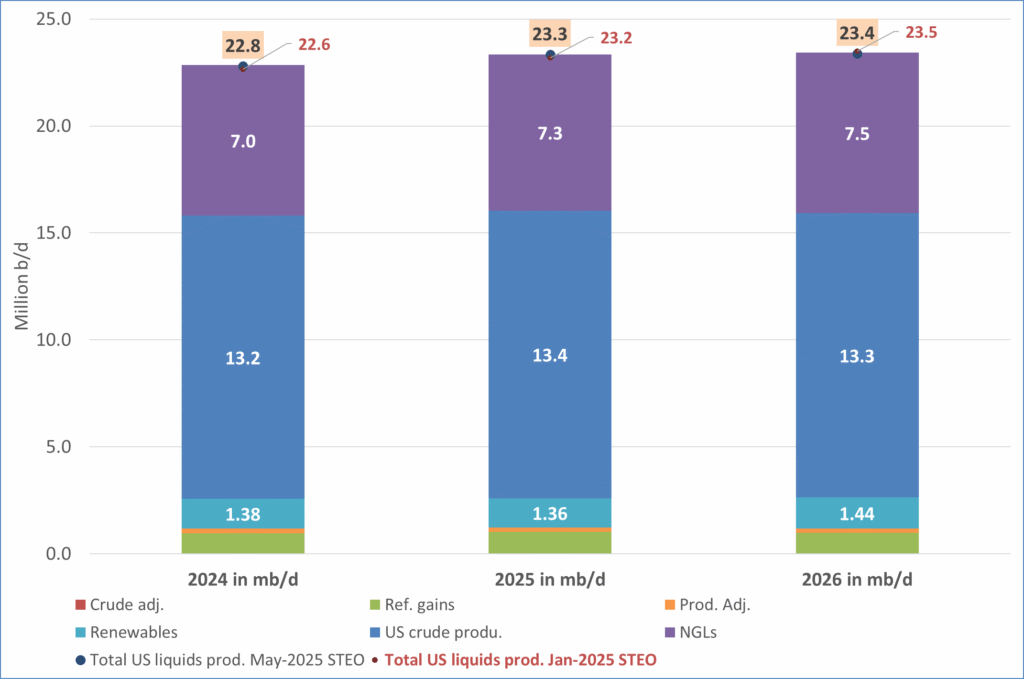
US IEA STEO September report. US crude oil production contracting in 2026, but NGLs still growing. Close to zero net liquids growth in total.

-

 Nyheter4 veckor sedan
Nyheter4 veckor sedanMeta bygger ett AI-datacenter på 5 GW och 2,25 GW gaskraftverk
-
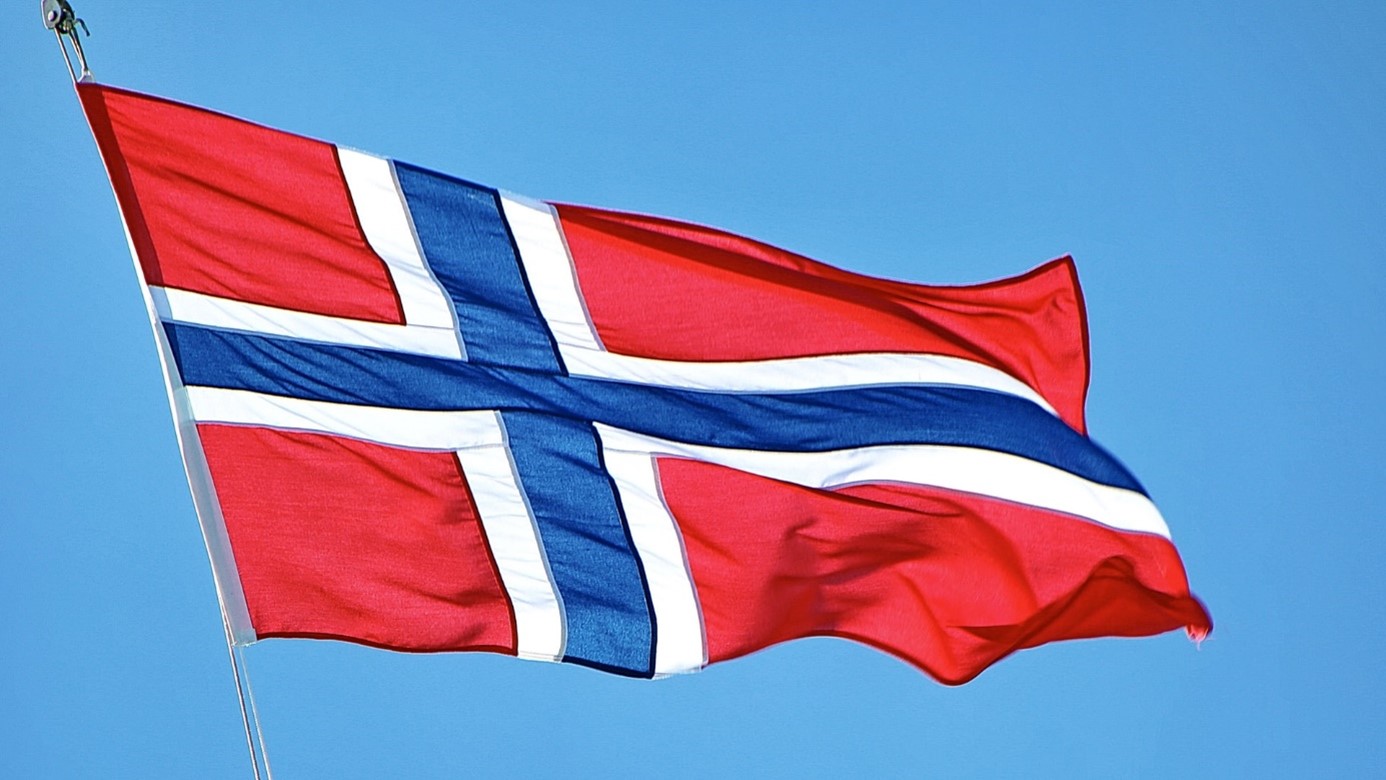
 Nyheter4 veckor sedan
Nyheter4 veckor sedanAker BP gör ett av Norges största oljefynd på ett decennium, stärker resurserna i Yggdrasilområdet
-

 Nyheter4 veckor sedan
Nyheter4 veckor sedanSommarens torka kan ge högre elpriser i höst
-

 Analys4 veckor sedan
Analys4 veckor sedanBrent edges higher as India–Russia oil trade draws U.S. ire and Powell takes the stage at Jackson Hole
-
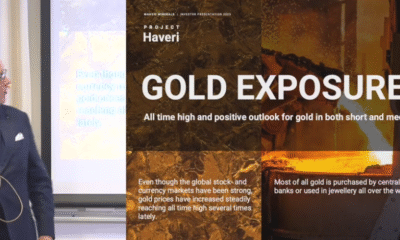
 Nyheter3 veckor sedan
Nyheter3 veckor sedanMahvie Minerals är verksamt i guldrikt område i Finland
-

 Analys3 veckor sedan
Analys3 veckor sedanIncreasing risk that OPEC+ will unwind the last 1.65 mb/d of cuts when they meet on 7 September
-

 Nyheter3 veckor sedan
Nyheter3 veckor sedanNeil Atkinson spår att priset på olja kommer att stiga till 70 USD
-

 Analys2 veckor sedan
Analys2 veckor sedanOPEC+ in a process of retaking market share


